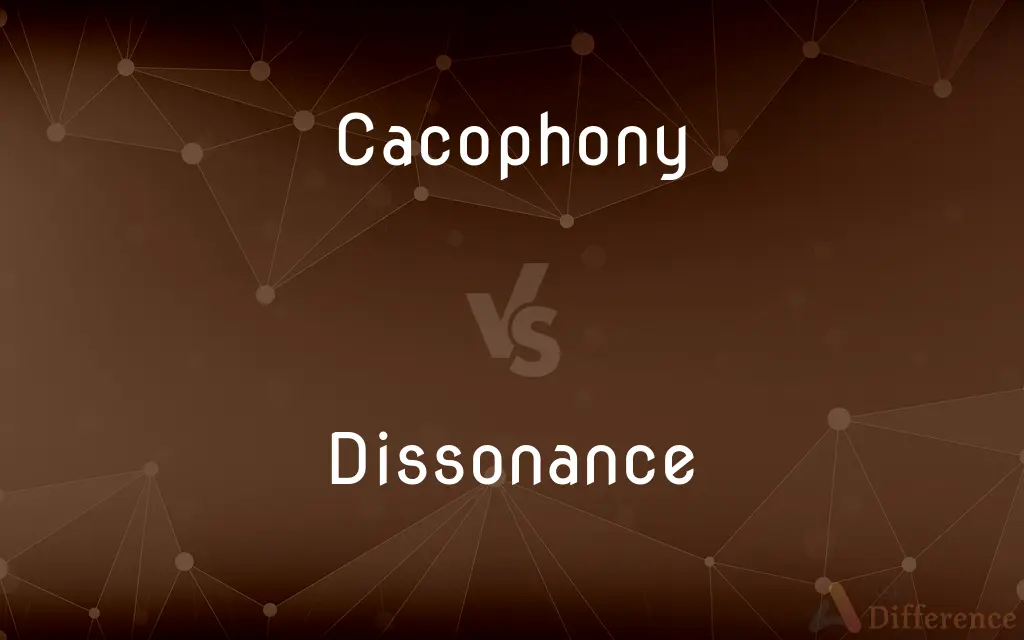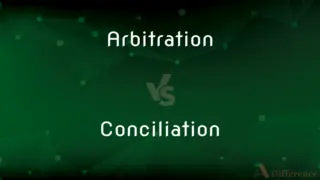Cacophony vs. Dissonance — What's the Difference?
By Maham Liaqat & Urooj Arif — Updated on May 2, 2024
Cacophony refers to a harsh mixture of sounds, often perceived as unpleasant noise, while dissonance involves a lack of harmony among musical notes but can also describe conflict in ideas.

Difference Between Cacophony and Dissonance
Table of Contents
ADVERTISEMENT
Key Differences
Cacophony is generally used to describe any collection of sounds that is jarring and unpleasant to the ear, often involving disparate or clashing noises. On the other hand, dissonance in music refers to a combination of tones that clashes, creating a sense of tension and instability until resolved.
In literature, cacophony is employed as a device to convey disorder or a disruptive atmosphere through harsh or discordant sounds in narrative or poetry. Conversely, dissonance can be used in rhetoric to describe conflicting ideas or feelings that create a sense of discord or unsettledness in the context of a dialogue or argument.
The term cacophony is derived from the Greek words "kakos" (bad) and "phone" (voice, sound), emphasizing the negative auditory experience. Whereas, dissonance comes from "dissonare" (to sound apart), highlighting a separation or clash in harmonious sounds.
While cacophony usually describes an undesirable noise without any specific purpose other than its stark sound, dissonance is often deliberately used in music to create tension or emotional response, which is resolved when moving to consonance.
Cacophony often appears in everyday environments where multiple unpleasant sounds occur simultaneously, such as traffic noise, loud machinery, or crowded areas. In contrast, dissonance is more commonly associated with artistic and theoretical contexts, particularly in music and psychology.
ADVERTISEMENT
Comparison Chart
Definition
Harsh, discordant mixture of sounds
Lack of harmony among musical notes; conflict in ideas
Context
Audio environments, literature
Music, psychology, rhetoric
Origin
Greek: "kakos" + "phone"
Latin: "dissonare"
Purpose
To evoke discomfort or chaos
To create tension or illustrate conflict
Usage
Describes unpleasant sound environments
Used in music and as a metaphor for conceptual conflict
Compare with Definitions
Cacophony
Can occur naturally, like in a storm with clashing thunders.
The cacophony of the storm terrified the small children.
Dissonance
Refers to a lack of agreement or harmony between people or ideas.
There was noticeable dissonance between the two leaders during the negotiations.
Cacophony
Generally has a negative connotation, implying discomfort.
He left the party early due to the unbearable cacophony.
Dissonance
Can be resolved to consonance in a musical context, providing relief.
The dissonance resolved into a beautiful chord that pleased the audience.
Cacophony
A harsh, discordant mixture of sounds.
The cacophony of horns during rush hour was overwhelming.
Dissonance
A combination of sounds that clash, used especially in music.
The composer used dissonance to build suspense in the piece.
Cacophony
Used in literature to describe a jarring, unpleasant sound effect.
The author used cacophony to reflect the chaos in the scene.
Dissonance
Often intentional in music to create emotional depth.
Dissonance in the symphony added complexity to the performance.
Cacophony
Often associated with noise in urban environments.
The cacophony outside the window made it hard to concentrate.
Dissonance
Used metaphorically in discussions of cognitive and social conflicts.
Cognitive dissonance keeps her from accepting the evidence.
Cacophony
A harsh discordant mixture of sounds
A cacophony of deafening alarm bells
Dissonance
Lack of harmony among musical notes
A session full of jangling dissonances
An unusual degree of dissonance for such choral styles
Cacophony
Jarring, discordant sound; dissonance
Heard a cacophony of horns during the traffic jam.
Dissonance
A harsh, disagreeable combination of sounds; discord.
Cacophony
The use of harsh or discordant sounds in literary composition, as for poetic effect.
Dissonance
Lack of agreement, consistency, or harmony; conflict
"In Vietnam, reality fell away and dissonance between claim and fact filled the void" (Michael Janeway).
Cacophony
A mix of discordant sounds; dissonance.
Dissonance
(Music) A combination of tones contextually considered to suggest unrelieved tension and require resolution.
Cacophony
An uncouth or disagreable sound of words, owing to the concurrence of harsh letters or syllables.
Dissonance
A harsh, discordant combination of sounds.
Cacophony
A combination of discordant sounds.
Dissonance
(music) Conflicting notes that are not overtones of the note or chord sounding.
Cacophony
An unhealthy state of the voice.
Dissonance
A state of disagreement or conflict.
Cacophony
A loud harsh or strident noise
Dissonance
(countable) An instance of disharmony or disjunction; a clash.
Cacophony
Loud confusing disagreeable sounds
Dissonance
A mingling of discordant sounds; an inharmonious combination of sounds; discord.
Filled the air with barbarous dissonance.
Dissonance
Want of agreement; incongruity.
Dissonance
A conflict of people's opinions or actions or characters
Dissonance
The auditory experience of sound that lacks musical quality; sound that is a disagreeable auditory experience;
Modern music is just noise to me
Dissonance
Disagreeable sounds
Common Curiosities
What is cacophony in music?
In music, cacophony refers to a harsh, discordant combination of sounds.
What is the difference between cacophony and noise?
Cacophony specifically refers to a mix of particularly harsh and jarring sounds, whereas noise can refer to any unwanted sound.
Why is dissonance important in music?
Dissonance is crucial in music for creating tension and emotional depth, which enhances the listener's experience through contrast and
Can dissonance be pleasant?
Dissonance can be subjectively pleasant within a musical context, as it creates tension which makes the resolution more satisfying.
How can dissonance be resolved in music?
In music, dissonance can be resolved by following it with consonance, which are harmonious sounds that provide a sense of relief and satisfaction to the listener.
What are examples of cacophony in nature?
Examples of cacophony in nature include the clashing sounds during a thunderstorm, or the discordant noises made by a large flock of cawing crows.
Can dissonance be a creative tool?
Yes, dissonance is often used as a creative tool in various forms of art and literature to challenge the audience's expectations and evoke more profound thought or emotional responses.
How does one identify cacophony in everyday life?
Cacophony in everyday life can be identified in environments where there is a mix of harsh, competing sounds such as in busy traffic, construction sites, or crowded urban areas.
Can dissonance occur in visual arts?
Yes, dissonance can also refer to a clash of visual elements that are not harmonious, creating a similar tension and conflict as in music, often used to convey a particular message or evoke emotions.
How is cacophony used in writing?
Writers use cacophony to convey disruption, chaos, or an intense sensory experience through jarring and discordant word sounds.
Is cacophony always considered negative?
Generally, cacophony is perceived negatively because it involves harsh and jarring sounds, but it can be used effectively in art and literature to convey specific atmospheres or emotions.
What is an example of dissonance in psychology?
In psychology, cognitive dissonance refers to the mental discomfort experienced when a person holds contradictory beliefs or values, or when their actions contradict their beliefs.
How can understanding dissonance improve musical performance?
Understanding dissonance can help musicians and composers to more effectively use tension and release in their performances, enhancing the emotional and dynamic range of their music.
Is dissonance always intentional in music compositions?
Dissonance in music is often intentional, used by composers to add complexity and emotional depth to their compositions, though it can also occur unintentionally when instruments are out of tune.
How does cacophony affect communication?
Cacophony can significantly hinder effective communication by making it difficult to hear and process speech or other important sounds in an environment.
Share Your Discovery

Previous Comparison
Arbitration vs. Conciliation
Next Comparison
Ethanol vs. IsopropanolAuthor Spotlight
Written by
Maham LiaqatCo-written by
Urooj ArifUrooj is a skilled content writer at Ask Difference, known for her exceptional ability to simplify complex topics into engaging and informative content. With a passion for research and a flair for clear, concise writing, she consistently delivers articles that resonate with our diverse audience.
















































